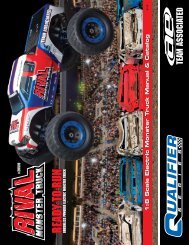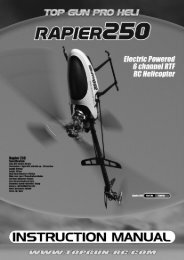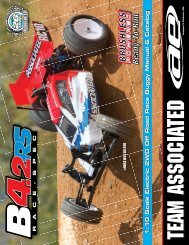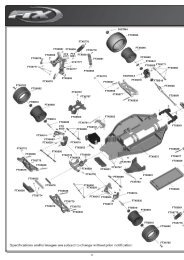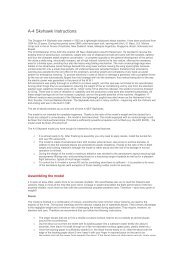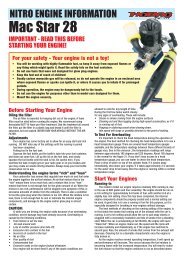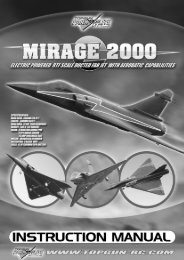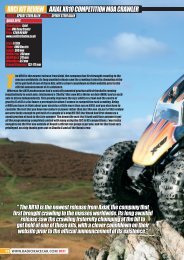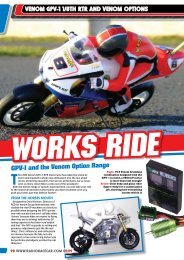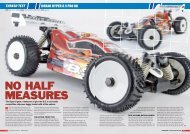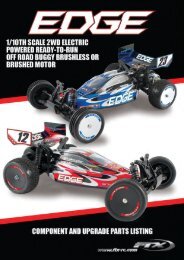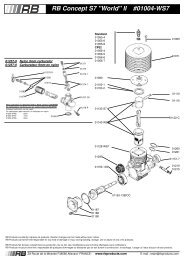Axial SWX Crawler reviewed in RRCi - CML Distribution
Axial SWX Crawler reviewed in RRCi - CML Distribution
Axial SWX Crawler reviewed in RRCi - CML Distribution
You also want an ePaper? Increase the reach of your titles
YUMPU automatically turns print PDFs into web optimized ePapers that Google loves.
The front assembly was completed, by add<strong>in</strong>g two M3 bolts to hold<br />
each ‘C’ hub <strong>in</strong> place. I realised when fitt<strong>in</strong>g these that the mould<strong>in</strong>gs<br />
on the axle cas<strong>in</strong>gs are smooth all the way around with noth<strong>in</strong>g to key<br />
the ‘C’ hubs other than the two M3 bolts. This would allow you to ‘clock’<br />
these hubs to any angle required just by re-drill<strong>in</strong>g the two holes <strong>in</strong><br />
a different position. If you make geometry changes <strong>in</strong> the future by<br />
alter<strong>in</strong>g l<strong>in</strong>k lengths the diff angle will change. Shorter bottom l<strong>in</strong>ks or<br />
longer top l<strong>in</strong>ks rotate the diff <strong>in</strong>put shaft upwards giv<strong>in</strong>g a better angle<br />
for the drive shafts and extra clearance <strong>in</strong> certa<strong>in</strong> situations when<br />
crawl<strong>in</strong>g. Just bear <strong>in</strong> m<strong>in</strong>d that as you rotate the front diff hous<strong>in</strong>g, you<br />
need to clock the ‘C’ hubs to counteract the castor change <strong>in</strong>duced,<br />
so the steer<strong>in</strong>g k<strong>in</strong>gp<strong>in</strong> stays as vertical as possible (zero castor) thus<br />
giv<strong>in</strong>g you a better turn<strong>in</strong>g circle and more precise steer<strong>in</strong>g.<br />
A DARk BuIlD<br />
The last job was to bolt all sub assemblies onto the chassis ensur<strong>in</strong>g<br />
you orientate the gearbox mount<strong>in</strong>g holes <strong>in</strong> the skid plate opposite<br />
the cut-out vertical chassis plate for the motor (and yes I put it the<br />
wrong way round the first time!)<br />
Top Tip<br />
Tap all the M3 holes on the skidplate first, as Delr<strong>in</strong> is a very hard<br />
material for screws to self-thread <strong>in</strong>to.<br />
The skid plate has a channel cut <strong>in</strong> the bottom face that helps stop<br />
you slipp<strong>in</strong>g laterally if you ground it over rocks or obstacles when<br />
runn<strong>in</strong>g the rig. All bolts on the sides of the chassis are countersunk<br />
to avoid catch<strong>in</strong>g on rocks and the chassis itself is very narrow <strong>in</strong><br />
comparison to the standard <strong>Axial</strong> item allow<strong>in</strong>g you to squeeze through<br />
gaps not possible with a stock rig as long as your bodyshell will allow.<br />
As the motor and transmission are wider once assembled than the<br />
chassis itself, Brad has made the motor side of the chassis open<br />
without a top bar, and even though this looks weird at first, <strong>in</strong> use it’s<br />
not an issue and caused no hang ups or damage to the motor or its<br />
mount<strong>in</strong>g plate.<br />
Below: Pro-L<strong>in</strong>e Eight Shooter beadlocks<br />
with memory foam <strong>in</strong>serts ready to<br />
assemble after add<strong>in</strong>g weights to rims<br />
Above: An assembled<br />
weight of 14 oz for each<br />
front, and 8 oz for each<br />
rear, ready to crawl<br />
Below: Completed roll<strong>in</strong>g chassis ready<br />
for electrics, check all l<strong>in</strong>ks move freely<br />
without b<strong>in</strong>d<strong>in</strong>g for smooth shock<br />
movement and better traction<br />
<strong>RRCi</strong> fEAtuRE<br />
The geometry of the chassis allows you to fit shocks between 100<br />
mm and 120 mm <strong>in</strong> length and still give good ground clearance while<br />
ma<strong>in</strong>ta<strong>in</strong><strong>in</strong>g a low centre of gravity. The more you lay the shocks down,<br />
the softer the set-up becomes. Endless variations are possible with<br />
enough mount<strong>in</strong>g holes to achieve whatever angle works for you. I<br />
opted to use the end mount holes as my shorter 100 mm Losi shocks<br />
fitted perfectly <strong>in</strong> that position and still allowed a good level of ground<br />
clearance.<br />
The supplied <strong>SWX</strong> l<strong>in</strong>ks were a breeze to assemble, I used new<br />
plastic rod ends and made sure that when fix<strong>in</strong>g them to the l<strong>in</strong>ks that<br />
the balls were able to move freely and the rod ends were not over<br />
tightened. I then custom made a set of comb<strong>in</strong>ation ‘4-l<strong>in</strong>k’ and servo<br />
mount plates from sheet Delr<strong>in</strong> to put the ends of the top l<strong>in</strong>ks under<br />
these plates and remove the <strong>Axial</strong> Y-pieces from the assembly. Built as<br />
standard the <strong>Axial</strong> items work f<strong>in</strong>e, but I have found a true ‘4-l<strong>in</strong>k’ more<br />
stable <strong>in</strong> use as it stops over articulation and once the shocks are setup<br />
correctly reduces torque twist significantly.<br />
I then turned to my wheels and tyres. I added lead ballast to the front<br />
Pro-L<strong>in</strong>e Eight Shooter rims to make the total weight with Badland<br />
tyres and memory foam <strong>in</strong>serts 14 oz per assembly. The rears were<br />
left without weight at just 8 oz once built. This difference really helps<br />
a rig’s ability to climb ledges and descend very steep angles, by<br />
putt<strong>in</strong>g the balance po<strong>in</strong>t further forward. Different builders alter this<br />
weight bias, some even run without weight<strong>in</strong>g their front wheels and<br />
concentrate weight forward by plac<strong>in</strong>g split battery packs on the front<br />
axles. In test<strong>in</strong>g I’ve found that weight<strong>in</strong>g the wheels gives me a more<br />
predictable set-up and once you learn what your rig can and can’t do,<br />
it’s your driv<strong>in</strong>g style and ability to choose the right l<strong>in</strong>es that makes all<br />
the difference <strong>in</strong> a comp.<br />
Above: RC4WD alloy transmission case and hardened gears for<br />
hours of ma<strong>in</strong>tenance free crawl<strong>in</strong>g<br />
Above: RC4WD alloy ‘C’ Hubs and steer<strong>in</strong>g knuckles allow<br />
‘clock<strong>in</strong>g’ to ma<strong>in</strong>ta<strong>in</strong> castor and full steer<strong>in</strong>g lock<br />
02/09 WWW.RADIORACECAR.COM 65



